Swans belong to the waterfowl family Anatidae and the genus Cygnus. These birds are known for their elegant appearance and grace in the water. With their long necks and distinctive white feathers, swans are a familiar sight in many parts of the world.
Despite their large size and heavy bodies, swans are actually skilled fliers. All swans can fly, often seen soaring through the sky with powerful wings.
The ability to fly is an important trait for swans, as it allows them to migrate to different locations in search of food and suitable breeding grounds.
Swans are migratory birds and rely on their strong flying abilities to travel long distances between their breeding and wintering grounds. In addition, the ability to fly also helps swans to escape predators and navigate their environment more effectively.
Key Takeaways on Can Swans Fly
- All the swan species can fly.
- In North America, the mute swan is non-migratory while the tundra swan and trumpeter swan migrate south in the winter.
- Young swans can fly at 4 to 7 months from hatching.
Do mute swans fly?
Mute swans (Cygnus olor) are majestic birds, often seen gracing many a park or open area ponds and lakes. Due to its large size, the mute swan is considered among the heaviest flying birds in existence. Despite this, these swans are capable of flight and can travel short distances for short periods of time when searching for food or escaping danger.
On the other hand, mute swans tend to migrate much more slowly than other species because they rely on their webbed feet to propel them forward instead of flapping their wings. If necessary, these swans can also fly several miles at once to find better nesting areas or food sources.
The North American population of mute swans is largely non-migratory birds. These swans spend most of their time in the water.
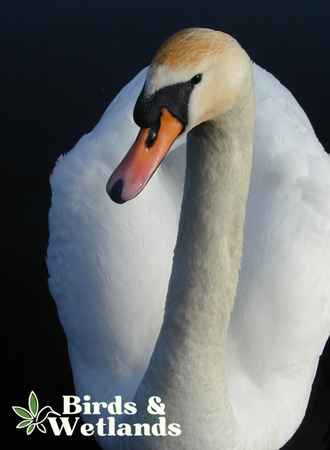
Do trumpeter swans fly?
Yes, the trumpeter swan can fly. These birds are known for their large size and powerful wings, which allow them to fly long distances and at high altitudes. In fact, these swans are the some of heaviest birds that can fly, with some individuals weighing up to 20 pounds. They can take off and fly despite their size due to their strong wing muscles and the length of their wings, which can span up to 8 feet from tip to tip.
Adult swans are also skilled at flying in formation, which helps them to conserve energy when flying long distances.
Do whooper swans fly?
Whooper swans have a wingspan reaching up to 2.3 meters, allowing them to soar through the sky and easily cover large distances. Their ability to fly makes whooper swans well-known.
They migrate annually between their breeding grounds in northern Europe and Asian tundra and their overwintering sites in western Europe, sometimes covering distances of up to 3,000 kilometers or more.
The strength of a whooper swan’s wings is important for its survival because it enables them to travel and find food sources in areas that are not accessible by foot. Additionally, the power of flight helps whooper swans protect themselves from predators by allowing them to escape if danger arises quickly.
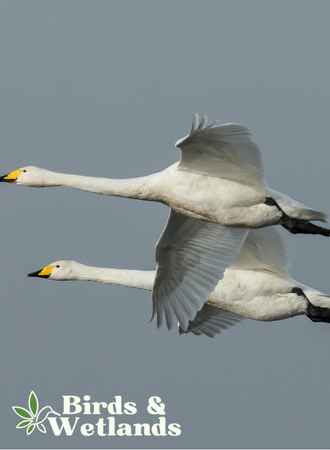
Do tundra swans fly?
Tundra swans (Bewick’s swan and whistling swan) have large, powerful wings that allow them to fly at high speeds and for long distances. They are migratory birds, traveling thousands of miles yearly between their breeding grounds in the Arctic and subarctic and their wintering grounds in the United States and Canada.
During their migration, tundra swans can fly at altitudes of up to 20,000 feet and at speeds of up to 50 miles per hour. This is truly impressive, given their large size. These birds can weigh 15-20 pounds and have a wingspan of up to 6 feet.
Tundra swan cygnets gain flight at 4 months, usually escorted by their parents.
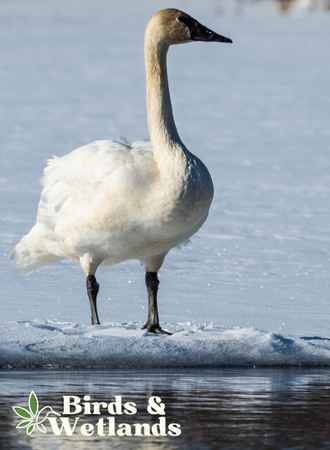
Do English swans fly?
English swans are mute, whooper, and Bewick’s varieties that all can fly to survive. These birds fly with great grace and speed over long distances for food, shelter and protection.
Flying is a great biological advantage for English swans as it allows the species to move from one place to another, often across different countries.
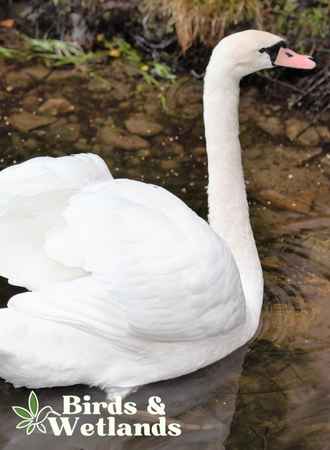
Do black swans fly?
Yes, black swans can fly. Black swans have long, slender wings that allow them to fly for long distances and to reach heights of up to 2,000 meters (6,500 feet). They are found in many parts of the world, including Australia, New Zealand, and parts of South America.
The black swan is known for its distinctive black feathers and red beak. The term black swan often refers to the Australian black swan and the black-necked swan.
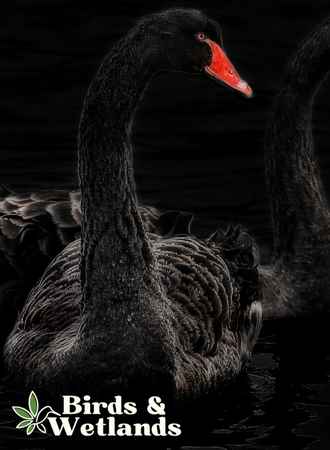
How fast can swans fly?
Most swans are known for their impressive flight abilities, reaching speeds of up to 50 miles per hour. Though the average speed is typically between 20 to 30 miles per hour, some flocks have been known to fly at impressive speeds of up to 70 miles per hour when they have a tailwind.
The Mute swan, in particular, is noteworthy for its incredible speed, reaching speeds of up to 80km per hour with its large wingspan, enabling it to cover great distances easily.
Swans vigorously flap their wings as they fly and glide periodically to conserve energy. They often fly in V-shaped formations, allowing reduced wind resistance for the birds in front, enabling them to travel faster. Skilled swans may even perform aerobatic feats such as loops and dives to showcase their talents.
How high can swans fly?
Swans possess impressive flying abilities, soaring to heights ranging from just a few hundred feet to an astounding 26,500 feet, depending on the species and the purpose of their flight.
For example, Whooper swans flying over Northern Ireland were captured flying at 26,500 feet. That’s over 8,000 meters!
On the other hand, tundra swans have been observed flying at altitudes of 6,000 to 8,000 feet during migration.
Additionally, species like mute swans tend to fly at elevations between 2,000 and 4,000 feet while traveling within their range or to perform shorter migrations.
Do all types of swans fly?
All swans are not flightless birds because they are capable of flying. However, how they fly – the distance, altitude and speed – varies considerably depending on the species and purpose of the flight.
For example, mute swans will generally only take to the air during the migration or if startled by an environmental threat, while other species, such as black swans, may choose to use flight as their preferred form of transportation.
On average, a swan’s wingspan can reach up to 3 feet (1 meter), making them incredibly powerful fliers. Depending on its species, a swan can travel at altitudes ranging from 10 – 15,000 feet (3-4 kilometers) and maintain speeds of around 30 – 60 miles per hour (50-100 km/h).
However, it should be noted that a captive swan may not be as capable at flighing as a wild swan.
Do all swans fly south in the winter?
Not all swans in North America fly south for the winter. The two main species that migrate are the tundra and trumpeter swans, who move south to avoid the cold weather and find better food sources.
These migration routes and patterns can vary depending on their geographical locations, as some may inhabit areas with mild winters and do not need to travel as far.
On the other hand, mute swans are a non-migratory species that stay year-round and have adapted to living in northern climates. These resident birds can find food sources even during the winter months.
How far can swans migrate?
Wild swans are known for their long-distance migrations, and different species can migrate at different distances. But how far can a swan fly?
The mute swan, a European species widely introduced elsewhere, for example, are mostly non-migratory, but some individual birds migrate short distances.
On the other hand, the whooper swan is migratory, with breeding populations in northern Europe and Asia, wintering in southern Europe, north Africa and south Asia. They can fly thousands of miles to reach their wintering grounds.
The journey of the whooper swan can be up to 3,000 miles (5,000 km) in a single migration. They will typically fly during the day and rest at night, often stopping to feed on the way. Some swans can fly hundreds of miles in a day.
Tundra swans also migrate long distances, with populations in North America traveling from as far as Arctic Alaska to wintering ground in Central America and the Atlantic and Pacific coasts of the USA.
In general, how far swans migrate depends on the swan species and average flying speed.
Do swans fly in formation?
Like other migratory birds, winter flocks of swans often fly in formation. When flying in formation, these large birds will usually fly in a V-shaped pattern, with the leader at the front of the V and the other birds following closely behind.
The V-shape formation helps reduce wind resistance for the birds flying behind the leader, making it easier for them to fly. Formation flying is also more energy-efficient for the migrating flock of swans.
By flying in a V-shape, the lead bird breaks through the air resistance, making it easier for the birds behind to follow. When the lead bird gets tired, one bird takes its place.
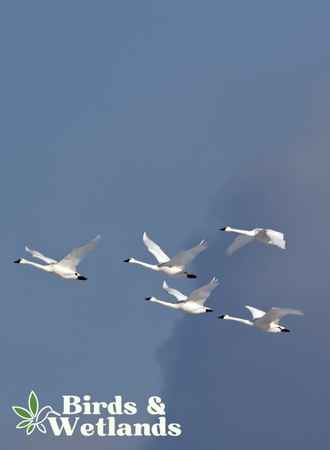
When can swan cygnets fly?
Young swans typically take 4 to 7 months to develop the strength and skills to fly. These young birds are born with a fluffy down coat that allows them to stay warm and float on the water, but they do not have the strong wing muscles or feathers necessary to fly until they are fully grown and gain their first flight feathers or flying feathers.

